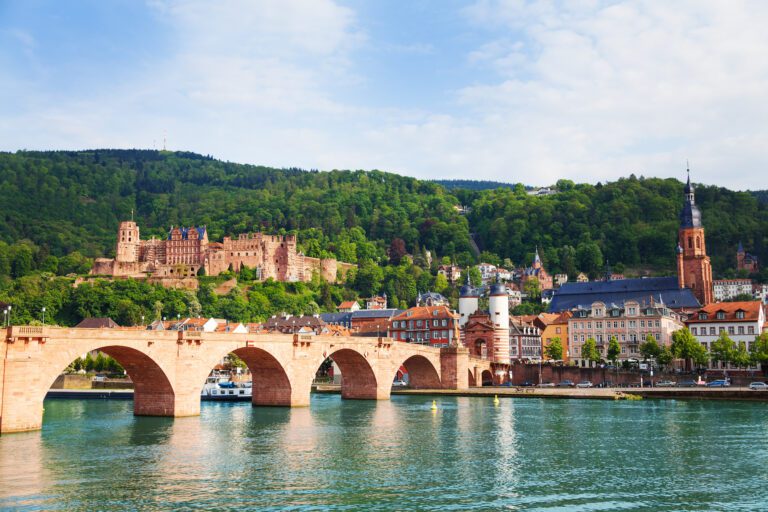The Upper Middle Rhine Valley, or as it’s more commonly known, the Romantic Rhine, is a UNESCO World Heritage Site and a castle lover’s dream come true. Along a 65-mile river stretch between Bingen and Koblenz , there are 40 castles, set against a backdrop of terraced vineyards and charming small towns pulsing with regional culture.
Some of these castles stand as majestic ruins, others have been lovingly restored and invite you inside for a closer look at their grand interiors. And for those who’ve ever fantasized about dining or even sleeping in a castle, you’re in luck—several offer top-notch culinary experiences and overnight stays.
In this guide, we’re offering you a curated look at 17 of the Rhine’s most unforgettable castles. We’ll categorize them for you: the ones you can explore, the ones where you can enjoy a meal, and even those where you can spend the night.
River Cruise on the Rhine
Want to see as many castles as you can in one go? A river cruise the best way to see several castles on the Rhine. Several companies offer these tours, with KD being the most prolific. You could cruise the entire stretch from Bingen/Ruedesheim to Koblenz and back, but keep in mind that this journey would take 6 hours upstream and 3.5 hours downstream. If you’d rather not spend your whole day on the water, you can opt for shorter segments. Consider the Lorelei Rock formation near Sank Goarhausen as a handy dividing line: tours south of Lorelei typically depart from Bingen/Ruedesheim, while those to the north start in Koblenz.
Castle Hotels on the Rhine
#1 Ehrenbreitstein Fortress (Festung Ehrenbreitstein)
Steeped in history, the fortress also offers panoramic vistas and a variety of activities to keep you entertained. On sunny days, a spacious patio beckons for some laid-back moments. If you’re up for a little challenge, try your hand at the adventure minigolf course. Little travelers aren’t left out either; an adventure playground is on hand to keep them thrilled.
The journey to Ehrenbreitstein itself is an experience. You can choose transportation via funicular or cable car. You’ll find boarding for the funicular about ½ mile from the Ehrenbreitstein train station, and it zips you up the hill in 3 minutes. The cable car starts at ‘Deutsches Eck’ in Koblenz’s city center and takes you up the hill in 5 minutes. If you happen to visit during winter, don’t miss the ‘Christmas Garden Koblenz,’ which lights up the castle in a mesmerizing display (note: separate ticketing and hours apply).
Built around the year 1000, this monumental fortress was prized for its strategic location. Various rulers and archbishops expanded it over the centuries. Despite facing numerous invading armies, the fortress remained intact. In 1799, however, it was invaded and destroyed by French revolutionary troops. It was rebuilt and completed in 1832. Interestingly, the fortress was not used for military purposes in the 19th century. However, the American flag was raised here following victories in both 1918 and 1945. Today, the fortress houses a Cultural Center and the Koblenz State Museum presenting exhibitions g on photography, archaeology, viticulture, culinary delights, and economic and cultural history. There is also a youth hostel within the confines of the fortress, which, if you ask me, is far from the worst place one could stay.
Tour: Audio Guides available in English allow you to learn about the fortress while you stroll across the vast area at your own pace. There are tours and living history tours, but they are only offered in German
Opening Hours: Apr 1- Nov 5, 2023: 10 am-6 pm, Nov 6- Mar 23, 2024: 10 am- 4 pm
#5 Liebenstein Castle (Schloss Liebenstein)
Liebenstein Castle, is one part of the ‘hostile brothers’ duo, the other being Sterrenberg Castle (#6 on our list). Liebenstein Castle invites you to dine in a restaurant that serves traditional German fare, all set against a backdrop of medieval ambiance. Whether you choose to eat indoors or on the rustic patio, the experience is sure to be memorable. For those looking to extend their visit, the family-run Castle Liebenstein hotel offers rooms furnished in authentic medieval style.
#7 Rheinfels
Built in 1245 by Count Diether of Katzenelnbogen (yes, the same guy behind Cat Castle), Rheinfels Castle stands as an expansive ruin along the Middle Rhine. Though it’s seen better days, the castle’s grandeur is still palpable, a testament to its unconquerable past under the landgraves of Hesse. Although it’s in ruins today, it is still an impressive site.
Opening Hours: Mar-Oct 9 am – 6 pm; Nov-Feb. 10 am – 3 pm
Tour: Visitors are welcome to explore the ruin complex at their own pace. There are also German language tours on the weekends between March and October.
Right next to Rheinfels Castle, you’ll find three restaurants serving up local and seasonal fare. For those looking to extend their stay, there’s also a 4-star luxury wellness resort complete with modern rooms, a pool, and a sauna.
#9 Schonburg Castle (Burg Schönburg)
Crafted in the 12th century, possibly by the legendary Count Palatine Hermann von Stahleck, Schönburg Castle in Oberwesel got a defensive upgrade from the Archbishops of Trier. Even after some 20th-century touch-ups, it’s still standing tall with its 20-meter shield wall intact.
The castle museum, open, takes you on a 700-year journey and even features a slingshot replica for a taste of medieval warfare. Don’t miss the jaw-dropping views from the museum tower’s viewing platform.
Opening Hours: Apr-Dec, Tuesday- Sunday
Hungry for more than just history? The ‘Castle Bistro’ serves up a knightly atmosphere, while the restaurant offers a fine dining experience. On sunny days, the patio is the place to be for those panoramic views. If you’re smitten and can’t bear to leave, Schönburg offers 29 rooms & suites in a 4-star setting. Bonus: hotel guests get exclusive access to the dreamy castle garden.
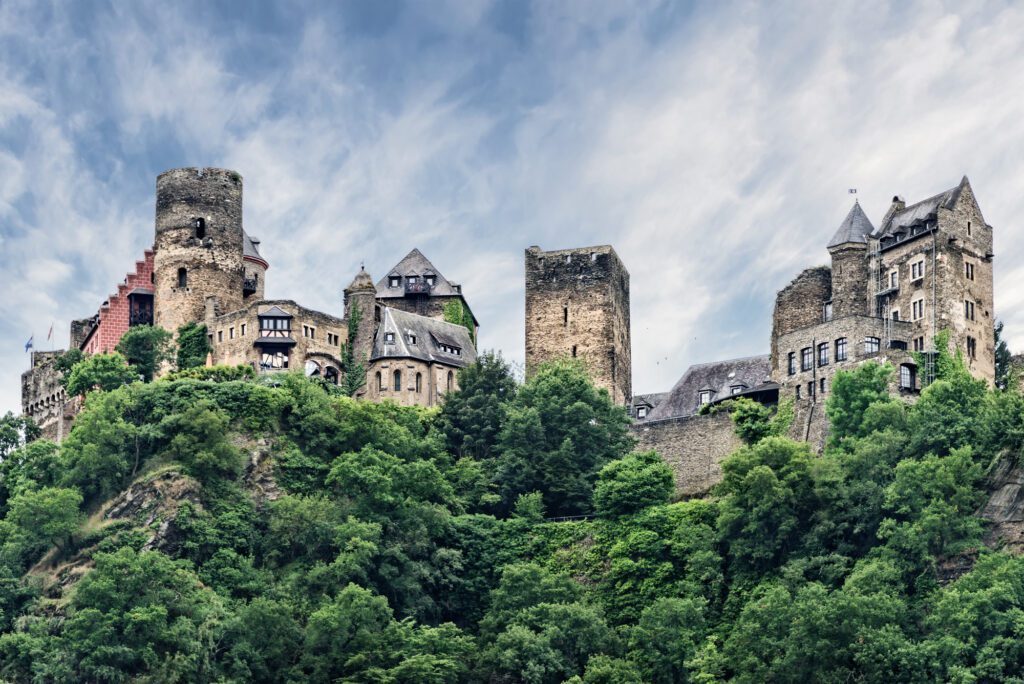
#10 Gutenfels Castle (Burg Gutenfels)
The lords of Falkenstein-Münzenberg built Gutenfels in 1222. Together with Pfalzgrafenstein Castle it helped to secure the toll for ships passing by on the Rhine.
Fast forward to today, and Gutenfels transformed into a cozy boutique hotel with just five fabulously unique rooms. Guests can unwind the library (with fireplace), and a sauna.
#12 Stahleck Castle (Burg Stahleck)
The year 1142/1143 marked a pivotal moment for both the town of Bacharach and Stahleck Castle, as Count Hermann von Stahleck was granted the County Palatine of the Rhine. Over time, the castle evolved into one of the Middle Rhine’s most formidable fortresses, with Bacharach serving as the command center for the Rhine County Palatine. Though Stahleck Castle suffered significant damage during the Thirty Years’ War, it was lovingly restored in 1666 due to the Count Palatine’s deep emotional connection to it. Unfortunately, the castle met its downfall in 1689 when French troops destroyed it during the Palatine War of Succession, leaving it in ruins until its 1925 reconstruction based on historical designs. Today, the castle plays host to a youth hostel.
#14 Reichenstein Castle (Burg Reichenstein)
Reichenstein Castle is the Rhine’s most recently reconstructed castle, and it has a dark and thrilling past. Once a notorious haven for robber barons in the 13th century, this castle was the stage for illegal raids, territorial grabs, and intense feuds. The lawlessness reached such heights that in 1290, King Rudolf of Habsburg not only laid siege to and destroyed the castle but also issued a ban on its reconstruction—after executing the resident robber knights, of course.
Today, Reichenstein Castle is a multi-faceted destination, featuring a museum, a restaurant, and a boutique hotel.
Opening Hours: May-Oct, 9 am – 5 pm, Nov-Apr, 9 am-5 pm (last entry 4 pm)
Tour: The museum offers an audio guide available in both German and English, recounting the castle’s 1,000-year-old saga (and there’s a kid-friendly version, too!). Little ones can even play pretend to be knights and princesses for some memorable photo ops.
As for dining, the restaurant serves up delectable cuisine paired with exceptional wines from the region. If you’re lucky, you might even get to savor a glass from the castle’s very own vineyard.
When it comes to accommodations, the hotel boasts 12 modern yet elegant rooms, offering a perfect blend of history and luxury.
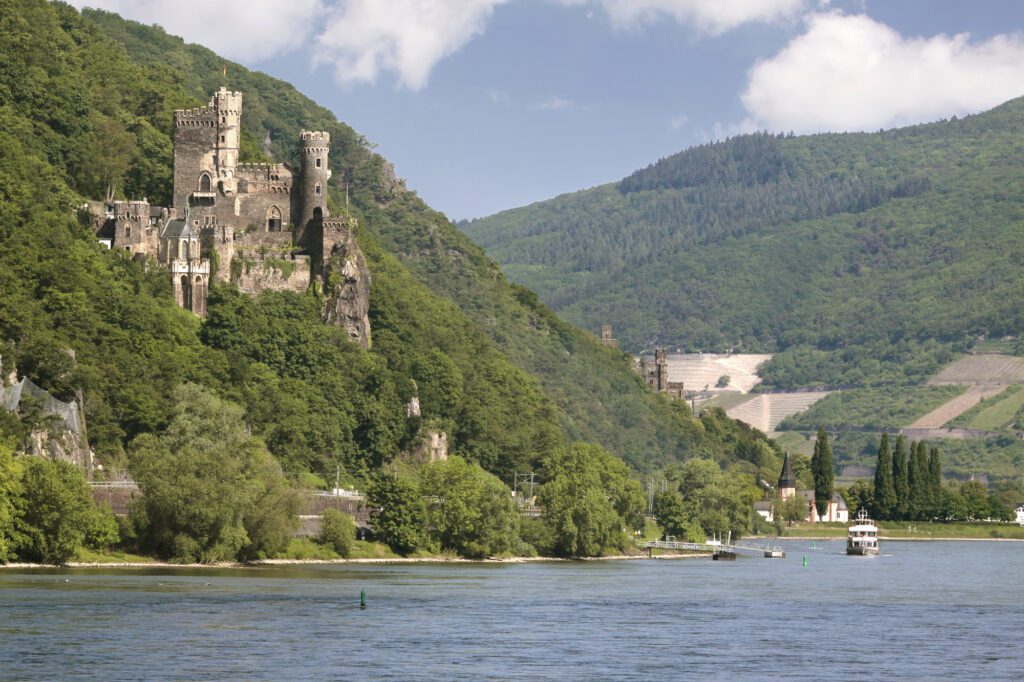
Other outstanding castles on the Rhine
#2 Stolzenfels Castle (Schloss Stolzenfels)
Considered the epitome of Rhine Romanticism, Schloss Stolzenfels is a true fairytale castle. Built as a strategic move by Archbishop Arnold II of Trier to rival the Archbishop of Mainz’s Lahneck Castle, Stolzenfels Castle once stood as a formidable guardian at the mouth of the Lahn River. Though it faced ruin during the Palatine War of Succession, a twist of fate came in 1823 when the city of Koblenz gifted the ruins to Prussian Crown Prince Frederick William IV. With the help of star architect Karl Friedrich Schinkel, the prince breathed new life into the castle, turning it into a grand residence while keeping its medieval charm intact.
Accessible from the Koblenz neighborhood of Stolzenfels, the walk up to the castle winds through a forested gorge. Along the way, you’ll pass a grotto, go under a viaduct, and encounter a waterfall—all before even reaching the castle’s beautifully landscaped gardens.
Opening Hours: Feb 1- Mar 14: Saturday, Sunday & Holidays: 10 am – 5 pm (last entry: 4 pm); Mar 15-Oct 31: Thursday-Sunday & Holidays: 10 am – 5 pm (last entry: 4 pm); Nov 1- Nov 30: Saturday, Sunday & Holidays: 10 am – 5 pm (last entry: 4 pm); Closed December & January
Tour: You can stroll through the castle and the gardens at your own pace. Inside the castle, you’ll see the historic living quarters with the original furniture and the great hall.
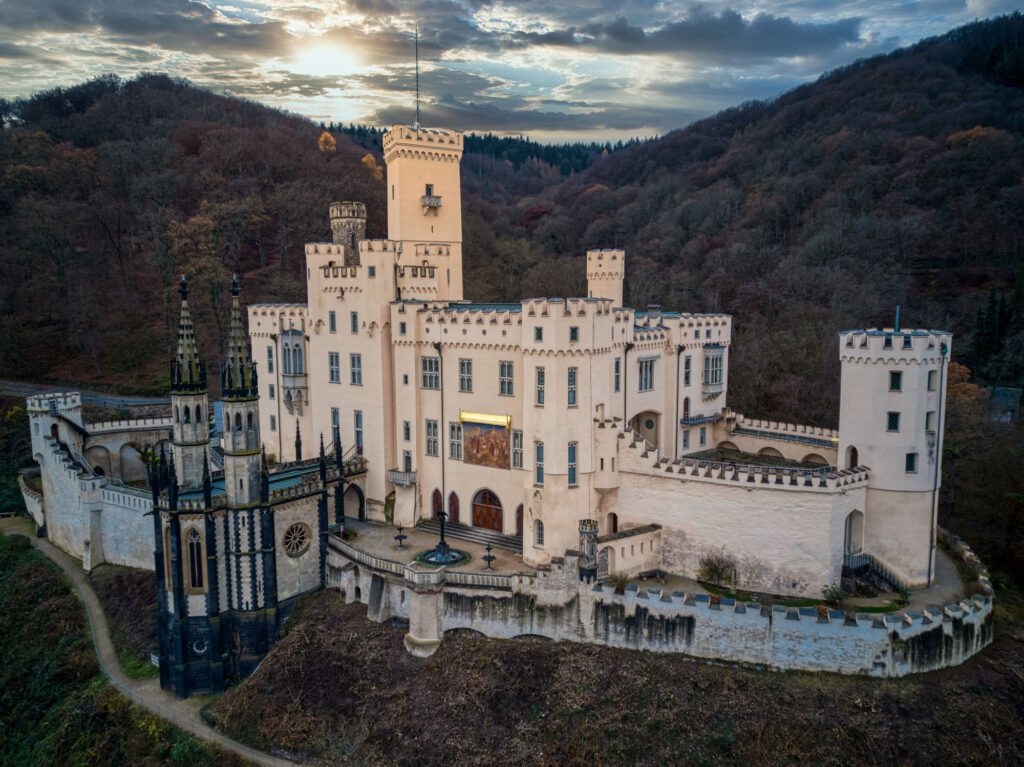
#3 Marksburg Castle
Marksburg is a medieval castle in the truest sense. Built between the 13th and 15th centuries, it’s only one of two castles on the Rhine that has never been destroyed, offering an authentic window into medieval life. The castle’s strategic location made it ideal for monitoring river traffic and defense. The value and significance of Marksburg Castle can be found in particular in its complete preservation as a medieval fortress. The impressive stronghold with most buildings dating back to the 13th to 15th century consists of wall rings containing keep, residential buildings, baileys, and bastions all on top of a hill above the small romantic town of Braubach, and with its interesting, typical interior rooms such as castle kitchen, great hall, bed chamber, chapel, armory, wine cellar, and battlements it allows us to travel back into the Middle Ages.
The castle welcomes guests for tours, featuring rooms such as the armory and chapel that have been meticulously restored to their original glory, offering you a tangible connection to history.
Opening Hours: The Castle is open daily between 10 am – 6 pm, with the last tour starting at 4 pm.
Tour: The castle can only be visited as part of a 50-minute guided tour. Tours take place in German daily 10 am – 5p m. A designated English-speaking tour takes place every day at 1 pm and 4 pm, but only during summer.

#4 Sterrenberg Castle (Burg Sterrenberg)
Sterrenberg Castle and the neighboring Liebenstein Castle are often referred to as the “hostile brothers.” The two castles are situated right next to each other, but they are separated by a shield wall. Legend has it that two brothers named ‘von Sterrenberg’ and ‘von Liebenstein’, cheated their blind sister out of her inheritance, using the ill-gotten wealth to build separate castles. Their deceit led to a bitter feud, culminating in a tragic hunting accident. One brother accidentally shot the other through the heart with an arrow. Wracked with guilt, the surviving brother journeyed to the Holy Land, where he met his own end. The legend of the two castles was immortalized by German poet Heinrich Heine in his poem “Zwei Brüder” (Two Brothers).
Today, Sterrenberg Castle is an event location, with varying public and private events throughout the year. There are also occasional group tours offered.
#6 Mouse” Castle (Burg Maus) #8 Katz Castle – “Cat” Castle (Burg Katz)
“The ‘Cat and Mouse’ rivalry isn’t just a saying; it’s etched into the architecture of two iconic Rhine Valley castles. Mouse Castle, or Deuernburg, was built in 1356 by Trier Archbishop Boemund II as a direct challenge to the upstream Rheinsfels Castle, owned by the counts of Katzenelnbogen. Not to be outdone, these counts swiftly built Neu-Katzenelnbogen, later known as Cat Castle, as their own form of medieval one-upmanship. These two fortresses are among the Rhine Valley’s most famous landmarks. Unfortunately, none of them are currently open for visitors.
#11 Pfalzgrafenstein Castle (Burg Pfalzgrafenstein)
Situated amidst the currents of the Rhine, the quaint Pfalzgrafenstein Castle—often simply called Pfalz Castle—is accessible only by ferry. This ‘stony ship’ was commissioned by King Ludwig of Bavaria and Count Palatine, primarily to serve as a toll station for passing ships. After all, royal life didn’t come cheap! This move was much to the chagrin of the Catholic Church and the bishops in Trier, who had a firm grip on the toll trade. Today, Pfalzgrafenstein Castle stands as one of the most photographed landmarks along the Rhine and can be visited via a ferry from the town of Kaub.
Visitor Info: As of the publication of this article, Pfalzgrafenstein Castle was closed.
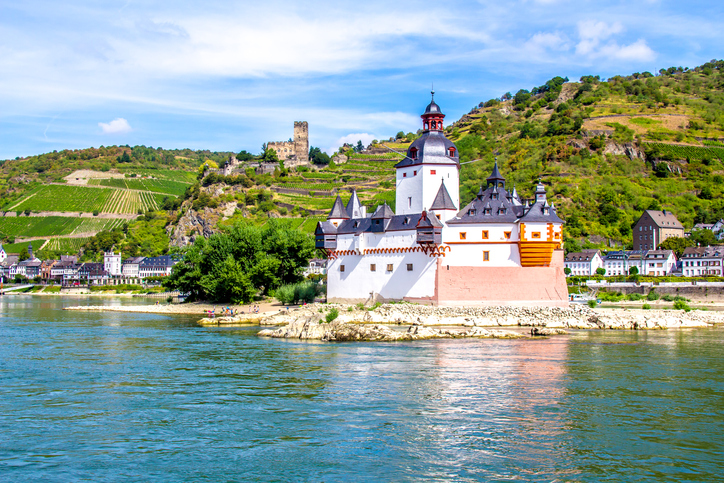
#13 Sooneck Castle (Burg Sooneck)
Sooneck Castle epitomizes the romantic essence of the Rhine region. It was constructed in the 13th century and is steeped in lore as a haven for infamous robber barons. While most castles on the Rhine are marked by tension and rivalries between ruling parties, Sooneck was collaboratively utilized by four Prussian princes as a hunting retreat. The estate is equally famous for the legend of Hans Veit, a blind crossbowman who allegedly killed the contentious castle lord, Siebold von Sooneck.
Opening Hours: Apr 1- Nov. 1, 10 am – 5 pm (last entry 4 pm)
Tour: You can explore it at your own pace with a self-guided tour. Inside, you’ll find rooms adorned with antique furniture and paintings that offer a window into work and life during the Middle Ages. Don’t miss the opportunity to take in the exceptional views of the Rhine Valley from the castle.
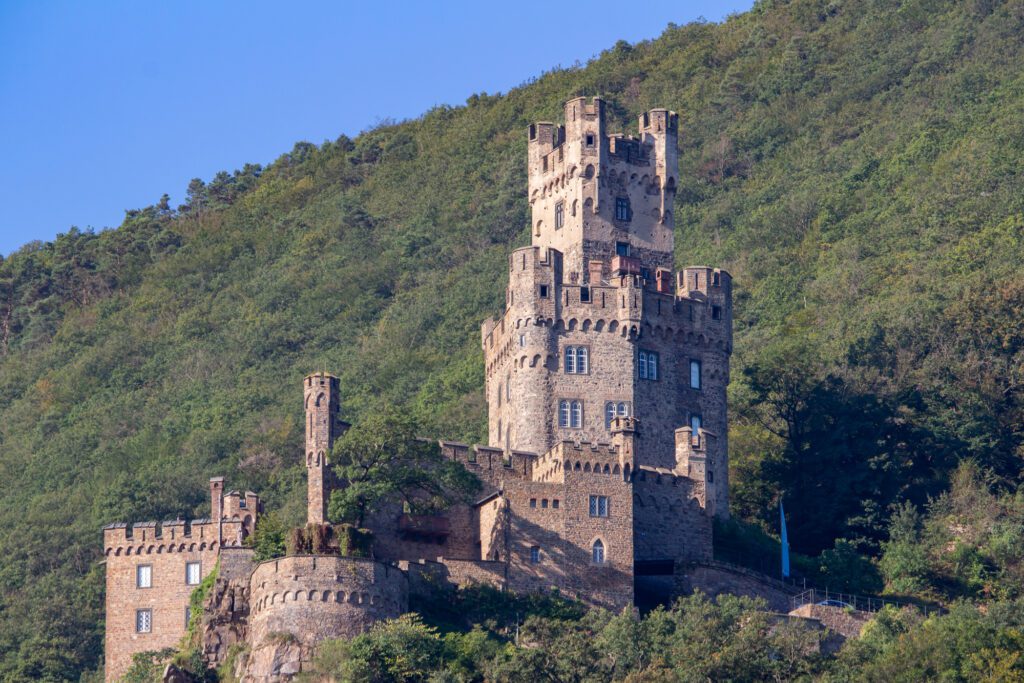
#12 Rheinstein Castle (Romantik-Schloss Burg Rheinstein)
From its 13th-century beginnings as a toll castle to its 19th-century Romantic makeover by Prince Friedrich Wilhelm of Prussia, this castle has certainly seen its share of history. After decaying into ruins in the 17th century, it was lovingly restored by the prince and remained a Hohenzollern family gem until 1975.
Now privately owned, the castle boasts a museum and an inviting restaurant with a patio—though you’ll need to tour the museum to dine there. The museum offers a curated collection ranging from antique furniture and knights’ armor to stained glass windows and frescos. For a tranquil moment, don’t overlook the romantic gardens, which offer a serene view over the Middle Rhine.
A special event is the Magical Christmas Market that runs at Burg Rheinstein from November 5 to December 19, 2023.
Opening Hours: Mar 18-Nov 5, 10 am 6 pm (last entry at 5 p.m.); Nov 6 -Dec 24, weekends 11 am 4:30 pm; special hours for the Magical Christmas market.
Tour: You are invited to explore the castle on your own.

#16 Burgruine Ehrenfels (Ehrenfels ruin) & Mouse Tower
Ehrenfels Castle served as toll collection station, in tandem with Mouse Tower upstream. Built in the 13th century, it belonged to the Archbishops of Mainz who not only built out the castle over the centuries, but also their wealth. The castle came under attack 1689 by French troops and was partially destroyed. The remains of the castle can be viewed from the outside only via a 45-60 minute walk from Rüdesheim.
#17 Klopp Castle (Burg Klopp)
Established in the 13th century by the Archbishops in Mainz, Klopp Castle initially served as a defensive stronghold at the Nahe River’s mouth. Its primary role was to shield clergy from local rebellions. However, in 1301, the castle faced significant damage during an attack led by King Albrecht I of Habsburg. The conflict was, unsurprisingly, about who had the authority to collect customs in the area.
Fast forward to the late 1800s, and the castle underwent a facelift, embracing neo-Gothic architectural elements and expanding its structure. Nowadays, the castle houses Bingen’s local government. The inner courtyard is open to the public year-round, yet it is the tower and its viewing platform (open only from April to October) that steals the show with its spectacular views over the Rhine valley. Inside the tower, you’ll find informational panels highlighting notable figures like Victor Hugo, Turnvater Jahn—the pioneer of physical education—and Richard Wagner, who have all visited the castle.
The castle also contains a small, but mighty fine restaurant, which offers regional wines. Reservation in advance is required!

